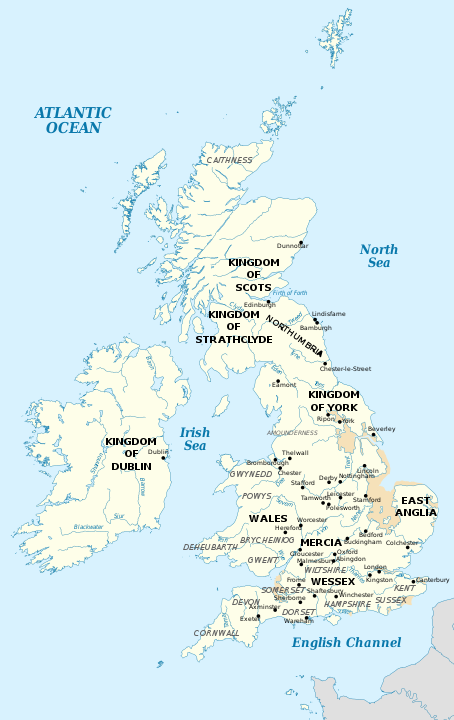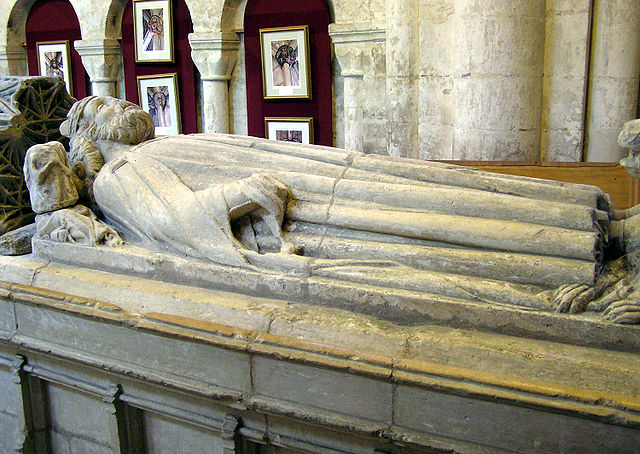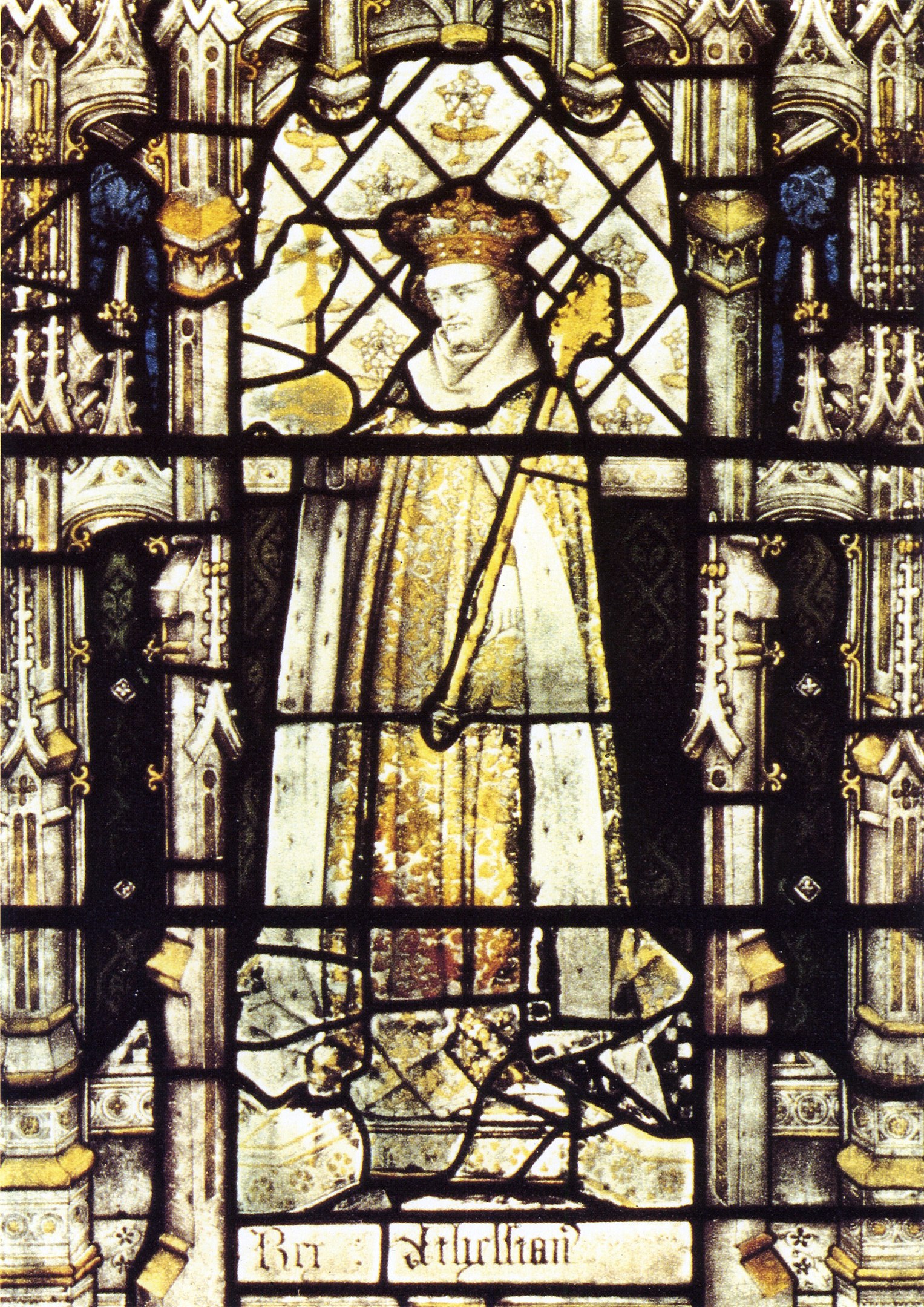Il 27 ottobre 939 d.c muore Athelstan, primo re d’Inghilterra, figlio di Edoardo il vecchio e nipote di Alfredo il Grande.
Nel IX secolo i molti regni del primo periodo anglosassone consolidati erano quattro: Wessex, Mercia, Northumbria e East Anglia. Nell’ottavo secolo, la Mercia era stato il regno più potente dell’Inghilterra meridionale, ma all’inizio del secolo successivo, il Wessex divenne dominante sotto il bis-bisnonno di Athelstan, Egbert. Verso la metà del secolo, l’Inghilterra subì un attacco crescente da parte delle incursioni vichinghe, culminate con l’invasione del “Great Heathen Army” (Grande Esercito Pagano) nell’865. Nell’878, i Vichinghi avevano invaso l’East Anglia, la Northumbria e la Mercia, e quasi conquistarono il Wessex. I Sassoni occidentali combatterono guidati da Alfredo il Grande e ottennero una vittoria decisiva nella battaglia di Edington. Alfred e il leader vichingo Guthrum concordarono su una divisione che dava ad Alfred la Mercia occidentale, mentre la Mercia orientale fu incorporata nella East Anglia vichinga. Negli anni 890, i nuovi attacchi vichinghi furono respinti con successo da Alfred, assistito da suo figlio (e padre di Æthelstan) Edward. Negli anni seguenti il figlio di Alfred, Edward, espanse il suo dominio fino a controllare, alla sua morte, tutta l’Inghilterra a sud dell’Humber.
Secondo William di Malmesbury, Athelstan aveva trent’anni quando salì al trono nel 924, il che significherebbe che nacque intorno all’894. Era il figlio maggiore di Edoardo il Vecchio e l’unico figlio di Edward dalla sua prima consorte, Ecgwynn. William di Malmesbury scrisse anche che Alfredo il Grande onorò il suo giovane nipote con una cerimonia in cui gli diede un mantello scarlatto, una cintura con gemme e una spada con un fodero dorato.

Quando Edoardo morì nel luglio del 924, Athelstan fu accettato dai Merciani come re. Il suo fratellastro Ælfweard avrebbe potuto essere stato riconosciuto come re nel Wessex, ma morì entro tre settimane dalla morte del padre. Æthelstan incontrò resistenza nel Wessex per diversi mesi prima di poter essere incoronato.
L’incoronazione di Athelstan ebbe luogo il 4 settembre 925 a Kingston upon Thames, forse a causa della sua posizione simbolica al confine tra Wessex e Mercia. Fu incoronato dall’arcivescovo di Canterbury, Athelm, che probabilmente progettò o organizzò un nuovo ordo (ordine di servizio religioso) in cui il re indossava per la prima volta una corona invece di un elmo. Il nuovo ordo fu influenzato dalla liturgia dei Franchi occidentali e a sua volta divenne una delle fonti dell’ordo francese medievale.
Nel 927 Athelastan conquistò l’ultimo regno vichingo rimasto, York, divenendo così il primo sovrano anglosassone di tutta l’Inghilterra. Nel 934 invase la Scozia e costrinse Costantino II a sottomettersi, ma il governo di Athelstan fu risentito dagli scozzesi e dai vichinghi, così nel 937 questi invasero l’Inghilterra. Athelstan li sconfisse nella battaglia di Brunanburh, una vittoria che gli diede un grande prestigio sia nelle isole britanniche che nel continente. Dopo la sua morte nel 939 i Vichinghi ripresero il controllo di York, che non fu riconquistata definitivamente fino al 954.
Athelstan centralizzò il governo; aumentò il controllo sulla produzione di Carte (documenti che concedevano diritti e privilegi) e convocò a consigliarlo figure di spicco provenienti da aree lontane. A queste riunioni hanno partecipato anche governanti al di fuori del suo territorio, in particolare re gallesi, che hanno così riconosciuto la sua signoria. Più testi legali sopravvivono del suo regno che di qualsiasi altro re inglese del X secolo. Questi documenti ci mostrano la preoccupazione di Athelstan per le rapine diffuse e la minaccia che rappresentavano per l’ordine sociale. Le riforme legali di Athelstan si basarono su quelle di suo nonno, Alfredo il Grande. Athelstan fu uno dei più devoti re del periodo ed era noto per collezionare reliquie e fondare chiese. La sua corte fu il centro dell’istruzione inglese durante il suo regno e gettò le basi per la riforma monastica benedettina più tardi nel secolo. Nessun altro re della Sassonia occidentale ha svolto un ruolo così importante nella politica europea come Athelstan, il quale organizzò i matrimoni di molte delle sue sorelle con governanti continentali.

Athelstan morì a Gloucester il 27 ottobre 939. Suo nonno Alfred, suo padre Edward e il suo fratellastro Ælfweard erano stati sepolti a Winchester, ma Athelstan scelse di non onorare la città associata all’opposizione al suo governo. Per suo desiderio fu sepolto nell’abbazia di Malmesbury, dove aveva seppellito i suoi cugini morti a Brunanburh. Nessun altro membro della famiglia reale della Sassonia occidentale fu sepolto lì e, secondo William di Malmesbury, la scelta di Athelstan rifletteva la sua devozione all’abbazia e alla memoria del suo abate del settimo secolo, Saint Aldhelm. William ha descritto Athelstan come biondo “come ho visto di persona nei suoi resti, meravigliosamente intrecciati con fili d’oro“. Le sue ossa andarono perdute durante la Riforma, ma è commemorato da una tomba vuota del XV secolo.
Immagine d’apertura: Athelastan raffigurato su una finestra di vetro colorato nella All Souls College Chapel, a Oxford
Bibliografia e fonti varie
- Abels, Richard (1998). Alfred the Great: War, Kingship and Culture in Anglo-Saxon England. Longman. ISBN 0-582-04047-7.
- Bailey, Maggie (2001). “Ælfwynn, Second Lady of the Mercians”. In N. J. Higham; D. H. Hill (eds.). Edward the Elder 899–924. Routledge. ISBN 0-415-21497-1.
- Beaven, Murray (1918). “King Edmund I and the Danes of York”. English Historical Review. 33 (129): 1–9. ISSN 0013-8266.
- Blair, John (2005). The Church in Anglo-Saxon Society. Oxford University Press. ISBN 978-0-19-921117-3.
- Brett, Caroline (1991). “A Breton pilgrim in England in the reign of King Æthelstan”. In Jondorf, Gillian; Dumville, D.N. (eds.). France and the British Isles in the Middle Ages and Renaissance. The Boydell Press. ISBN 0-85115-487-5.
- Brooke, Christopher (2001). The Saxon and Norman Kings. Wiley-Blackwell. ISBN 978-0-631-23131-8.
- Brooks, Nicholas (1984). The Early History of the Church of Canterbury. Leicester University Press. ISBN 0-7185-1182-4.
- Campbell, James (2000). The Anglo-Saxon State. Hambledon & London. ISBN 1-85285-176-7.
- Charles-Edwards, T. M. (2013). Wales and the Britons 350–1064. Oxford University Press. ISBN 978-0-19-821731-2.
- Cooper, Tracy-Anne (March 2013). “Æthelstan: The First King of England by Sarah Foot (review)”. Journal of World History. 24 (1): 189–192. doi:10.1353/jwh.2013.0025. S2CID 162023751.
- Costambeys, Marios (2004). “Æthelflæd [Ethelfleda] (d. 918), ruler of the Mercians”. Oxford Dictionary of National Biography. Oxford University Press. doi:10.1093/ref:odnb/8907. Retrieved 25 October 2013. (subscription or UK public library membership required)
- Cubitt, Catherine; Costambeys, Marios (2004). “Oda [St Oda, Odo] (d. 958), archbishop of Canterbury”. Oxford Dictionary of National Biography. Oxford University Press. doi:10.1093/ref:odnb/20541. Retrieved 9 December 2013. (subscription or UK public library membership required)
- Davies, John Reuben (2013). “Wales and West Britain”. In Stafford, Pauline (ed.). A Companion to the Early Middle Ages: Britain and Ireland c. 500–c. 1100. Wiley-Blackwell. ISBN 978-1-118-42513-8.
- Dumville, David (1992). Wessex and England from Alfred to Edgar: Six Essays on Political, Cultural, and Ecclesiastical Revival. Boydell Press. ISBN 978-0-85115-308-7.
- Foot, Sarah (2004). “Æthelstan (Athelstan) (893/4–939), king of England”. Oxford Dictionary of National Biography. Oxford University Press. doi:10.1093/ref:odnb/833. Retrieved 9 June 2012.(subscription or UK public library membership required)
- Foot, Sarah (2007). “Where English Becomes British: Rethinking Contexts for Brunanburh”. In Barrow, Julia; Wareham, Andrew (eds.). Myth, Rulership, Church and Charters. Ashgate. pp. 127–144. ISBN 978-0-7546-5120-8.
- Foot, Sarah (2011). Æthelstan: The First King of England. Yale University Press. ISBN 978-0-300-12535-1.
- Gretsch, Mechtild (1999). The Intellectual Foundations of the English Benedictine Reform. Cambridge University Press. ISBN 978-0-521-03052-6.
- Halloran, Kevin (September 2013). “Anlaf Guthfrithson at York: A Non-existent Kingship?”. Northern History. University of Leeds. 50 (2): 180–185. doi:10.1179/0078172X13Z.00000000042. S2CID 154514458.
- Hart, Cyril (1973). “Athelstan ‘Half King’ and his family”. Anglo-Saxon England. Cambridge University Press. 2: 115–144. doi:10.1017/s0263675100000375. ISBN 0-521-20218-3.
- Hart, Cyril (2004). “Sihtric Cáech (Sigtryggr Cáech) (d. 927), king of York”. Oxford Dictionary of National Biography. Oxford University Press. doi:10.1093/ref:odnb/49273. Retrieved 4 October 2012. (subscription or UK public library membership required)
- Higham, N. J. (1993). The Kingdom of Northumbria: AD 350–1100. Alan Sutton. ISBN 0-86299-730-5.
- Hill, Paul (2004). The Age of Athelstan: Britain’s Forgotten History. Tempus Publishing. ISBN 0-7524-2566-8.
- Hunter Blair, Peter (2003). An Introduction to Anglo-Saxon England (3rd ed.). Cambridge, UK: Cambridge University Press. ISBN 978-0-521-83085-0.
- Insley, Charles (2013). “Southumbria”. In Stafford, Pauline (ed.). A Companion to the Early Middle Ages: Britain and Ireland c. 500-c. 1100. Wiley-Blackwell. ISBN 978-1-118-42513-8.
- John, Eric (1982). “The Age of Edgar”. In Campbell, James (ed.). The Anglo-Saxons. Penguin Books. ISBN 0-14-014395-5.
- Karkov, Catherine E. (2004). The Ruler Portraits of Anglo-Saxon England. Boydell. ISBN 1-84383-059-0.
- Keynes, Simon; Lapidge, Michael, eds. (1983). Alfred the Great: Asser’s Life of King Alfred & Other Contemporary Sources. Penguin Classics. ISBN 978-0-14-044409-4.
- Keynes, Simon (1985). “King Æthelstan’s books”. In Lapidge, Michael; Gneuss, Helmut (eds.). Learning and Literature in Anglo-Saxon England. Cambridge University Press. pp. 143–201. ISBN 0-521-25902-9.
- Keynes, Simon (1990). “Royal government and the written word in late Anglo-Saxon England”. In McKitterick, Rosamund (ed.). The Uses of Literacy in Early Medieval Europe. Cambridge University Press. ISBN 0-521-34409-3.
- Keynes, Simon (1999). “England, c. 900–1016”. In Reuter, Timothy (ed.). The New Cambridge Medieval History. III. Cambridge University Press. pp. 456–484. ISBN 0-521-36447-7.
- Keynes, Simon (2001). “Edward, King of the Anglo-Saxons”. In N. J. Higham; D. H. Hill (eds.). Edward the Elder 899–924. Routledge. ISBN 0-415-21497-1.
- Keynes, Simon (2001). “Rulers of the English, c. 450–1066”. In Michael Lapidge; John Blair; Simon Keynes; Donald Scragg (eds.). The Blackwell Encyclopedia of Anglo-Saxon England. Blackwell Publishing. ISBN 978-0-631-22492-1.
- Keynes, Simon (2008). “Edgar rex admirabilis“. In Scragg, Donald (ed.). Edgar King of the English: New Interpretations. The Boydell Press. ISBN 978-1-84383-399-4.
- Lapidge, Michael (1993). Anglo-Latin Literature 900–1066. The Hambledon Press. ISBN 1-85285-012-4.
- Lapidge, Michael; Blair, John; Keynes, Simon; Scragg, Donald, eds. (2001). “The Blackwell Encyclopaedia of Anglo-Saxon England”. The Blackwell Encyclopedia of Anglo-Saxon England. Blackwell Publishing. ISBN 978-0-631-22492-1.
- Lapidge, Michael (2004). “Dunstan [St Dunstan] (d. 988), archbishop of Canterbury”. Oxford Dictionary of National Biography. Oxford University Press. doi:10.1093/ref:odnb/8288. Retrieved 7 December 2013. (subscription or UK public library membership required)
- Livingston, Michael, ed. (2011). The Battle of Brunanburh: A Casebook. University of Exeter Press. ISBN 978-0-85989-862-1.
- Livingston, Michael (2011). “The Roads to Brunanburh”. In Livingston, Michael (ed.). The Battle of Brunanburh: A Casebook. University of Exeter Press. pp. 1–26. ISBN 978-0-85989-862-1.
- Maclean, Simon (2013). “Britain, Ireland and Europe, c. 900–c. 1100”. In Stafford, Pauline (ed.). A Companion to the Early Middle Ages: Britain and Ireland c. 500-c. 1100. Wiley-Blackwell. ISBN 978-1-118-42513-8.
- Maddicott, John (2010). The Origins of the English Parliament, 924–1327. Oxford University Press. ISBN 978-0-19-958550-2.
- Miller, Sean (2001). “Æthelstan”. In Michael Lapidge; John Blair; Simon Keynes; Donald Scragg (eds.). The Blackwell Encyclopedia of Anglo-Saxon England. Blackwell Publishing. ISBN 978-0-631-22492-1.
- Miller, Sean (2004). “Edward [called Edward the Elder] (870s?–924), king of the Anglo-Saxons”. Oxford Dictionary of National Biography. Oxford University Press. doi:10.1093/ref:odnb/8514. Retrieved 28 April 2013. (subscription or UK public library membership required)
- Molyneaux, George (2015). The Formation of the English Kingdom in the Tenth Century. Oxford University Press. ISBN 978-0-19-871791-1.
- Nelson, Janet (1999). Rulers and Ruling Families in Early Medieval Europe. Ashgate. ISBN 0-86078-802-4.
- Nelson, Janet L. (1999). “Rulers and government”. In Reuter, Timothy (ed.). The New Cambridge Medieval History: Volume III c. 900–c. 1024. Cambridge University Press. ISBN 0-521-36447-7.
- Nelson, Janet (2008). “The First Use of the Second Anglo-Saxon Ordo“. In Julia Barrow; Andrew Wareham (eds.). Myth, Rulership, Church and Charters. Ashgate. ISBN 978-0-7546-5120-8.
- Ortenberg, Veronica (2010). “‘The King from Overseas: Why did Æthelstan Matter in Tenth-Century Continental Affairs?”. In Rollason, David; Leyser, Conrad; Williams, Hannah (eds.). England and the Continent in the Tenth Century: Studies in Honour of Wilhelm Levison (1876–1947). Brepols. ISBN 978-2-503-53208-0.
- Pratt, David (2010). “Written Law and the Communication of Authority in Tenth-Century England”. In Rollason, David; Leyser, Conrad; Williams, Hannah (eds.). England and the Continent in the Tenth Century: Studies in Honour of Wilhelm Levison (1876–1947). Brepols. ISBN 978-2-503-53208-0.
- Roach, Levi (August 2013). “Law codes and legal norms in later Anglo-Saxon England”. Historical Research. Institute of Historical Research. 86 (233): 465–486. doi:10.1111/1468-2281.12001.
- Roach, Levi (2016). Æthelred the Unready. Yale University Press. ISBN 978-0-300-22972-1.
- Ryan, Martin J. (2013). “Conquest, Reform and the Making of England”. In Higham, Nicholas J.; Ryan, Martin J. (eds.). The Anglo-Saxon World. Yale University Press. ISBN 978-0-300-12534-4.
- Scragg, Donald (2001). “Battle of Brunanburh”. In Michael Lapidge; John Blair; Simon Keynes; Donald Scragg (eds.). The Blackwell Encyclopedia of Anglo-Saxon England. Blackwell Publishing. ISBN 978-0-631-22492-1.
- Sharp, Sheila (Autumn 1997). “England, Europe and the Celtic World: King Athelstan’s Foreign Policy”. Bulletin of the John Rylands University Library of Manchester. 79 (3): 197–219. doi:10.7227/BJRL.79.3.15.
- Sharp, Sheila (2001). “The West Saxon Tradition of Dynastic Marriage”. In N. J. Higham; D. H. Hill (eds.). Edward the Elder 899–924. Routledge. ISBN 0-415-21497-1.
- Smyth, Alfred P (1984). Warlords and Holy Men: Scotland AD 80–1000. Edward Arnold. ISBN 0-7131-6305-4.
- Smyth, Alfred P. (1987). Scandinavian York and Dublin. Irish Academic Press. ISBN 0-7165-2365-5.
- Stafford, Pauline (2001). “Ealdorman”. In Michael Lapidge; John Blair; Simon Keynes; Donald Scragg (eds.). The Blackwell Encyclopedia of Anglo-Saxon England. Blackwell Publishing. ISBN 978-0-631-22492-1.
- Stenton, Frank (1971). Anglo-Saxon England (3rd ed.). Oxford University Press. ISBN 978-0-19-280139-5.
- Thacker, Alan (2001). “Dynastic Monasteries and Family Cults”. In N. J. Higham; D. H. Hill (eds.). Edward the Elder 899–924. Routledge. ISBN 0-415-21497-1.
- Trousdale, Alaric (2007). Rex Augustissimus: Reassessing the Reign of King Edmund of England, 939-46 (PhD). The University of Edinburgh.
- Williams, Ann (1991). “Ælfflæd queen d. after 920”. In Williams, Ann; Smyth, Alfred P.; Kirby, D. P. (eds.). A Biographical Dictionary of Dark Age Britain. Seaby. ISBN 1-85264-047-2.
- Williams, Ann (1991). “Athelstan, king of Wessex 924-39”. In Ann Williams; Alfred P. Smyth; D. P. Kirby (eds.). A Biographical Dictionary of Dark Age Britain. Seaby. ISBN 1-85264-047-2.
- Williams, Ann (1991). “Ealdred of Bamburgh”. In Ann Williams; Alfred P. Smyth; D. P. Kirby (eds.). A Biographical Dictionary of Dark Age Britain. Seaby. ISBN 1-85264-047-2.
- Wood, Michael (1983). “The Making of King Aethelstan’s Empire: An English Charlemagne?”. In Wormald, Patrick; Bullough, Donald; Collins, Roger (eds.). Ideal and Reality in Frankish and Anglo-Saxon Society. Basil Blackwell. pp. 250–272. ISBN 0-631-12661-9.
- Wood, Michael (1999). In search of England. Penguin. ISBN 0-14-024733-5.
- Wood, Michael (2005). In Search of the Dark Ages. BBC Books. ISBN 978-0-563-53431-0.
- Wood, Michael (2007). “‘Stand strong against the monsters’: kingship and learning in the empire of king Æthelstan”. In Wormald, Patrick; Nelson, Janet (eds.). Lay Intellectuals in the Carolingian World. Cambridge University Press. ISBN 978-0-521-83453-7.
- Wood, Michael (2010). “A Carolingian Scholar in the Court of King Æthelstan”. In Rollason, David; Leyser, Conrad; Williams, Hannah (eds.). England and the Continent in the Tenth Century: Studies in Honour of Wilhelm Levison (1876–1947). Brepols. ISBN 978-2-503-53208-0.
- Wood, Michael (20 August 2013). “Aethelstan: The First King of England”. King Alfred and the Anglo Saxons. Episode 3. BBC 4 Television.
- Woodman, D. A. (December 2013). “‘Æthelstan A’ and the rhetoric of rule”. Anglo-Saxon England. Cambridge University Press. 42: 217–248. doi:10.1017/S0263675113000112. S2CID 159948509.
- Woolf, Alex (2007). From Pictland to Alba: 789–1070. Edinburgh University Press. ISBN 978-0-7486-1233-8.
- Woolf, Alex (2013). “Scotland”. In Stafford, Pauline (ed.). A Companion to the Early Middle Ages: Britain and Ireland c. 500-c. 1100. Wiley-Blackwell. ISBN 978-1-118-42513-8.
- Wormald, Patrick (1999). The Making of English Law: King Alfred to the Twelfth Century. 1. Blackwell. ISBN 0-631-13496-4.
- Wormald, Patrick (2004). “Æthelweard [Ethelwerd] (d. 998?)”. Oxford Dictionary of National Biography. Oxford University Press. doi:10.1093/ref:odnb/8918. Retrieved 5 May 2013. (subscription or UK public library membership required)
- Yorke, Barbara (1997). Bishop Æthelwold: His Career and Influence. The Boydell Press. ISBN 978-0-85115-705-4.
- Yorke, Barbara (2001). “Edward as Ætheling”. In N. J. Higham; D. H. Hill (eds.). Edward the Elder 899–924. Routledge. ISBN 0-415-21497-1.
- Yorke, Barbara (2004). “Æthelwold (St Æthelwold, Ethelwold) (904×9–984)”. Oxford Dictionary of National Biography. Oxford University Press. doi:10.1093/ref:odnb/8920. Retrieved 5 March 2013. (subscription or UK public library membership required)
- Zacher, Samantha (2011). “Multilingualism at the Court of King Æthelstan: Latin Praise Poetry and The Battle of Brunanburh“. In Tyler, Elizabeth M. (ed.). Conceptualizing Multilingualism in England, c. 800-C. 1250. Brepols. ISBN 978-2-503-52856-4.

